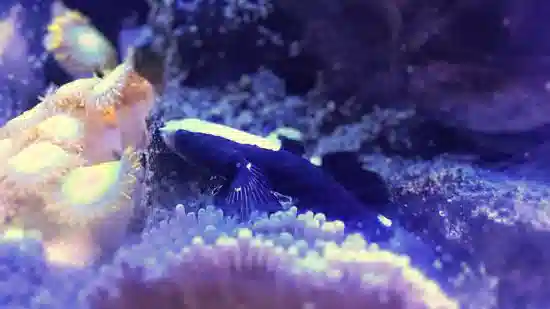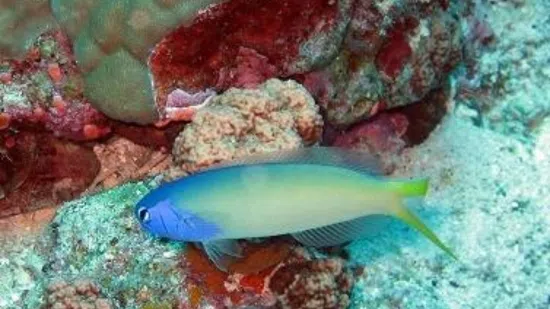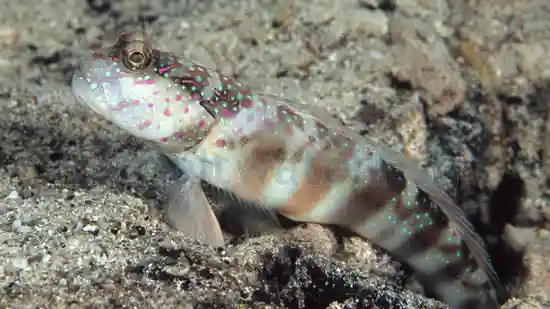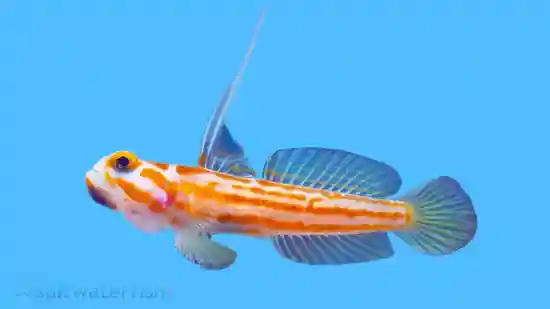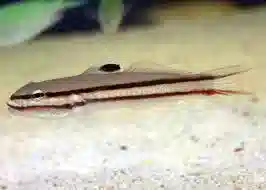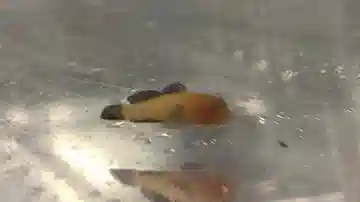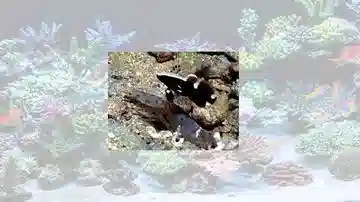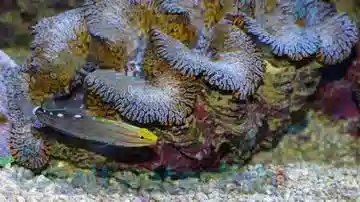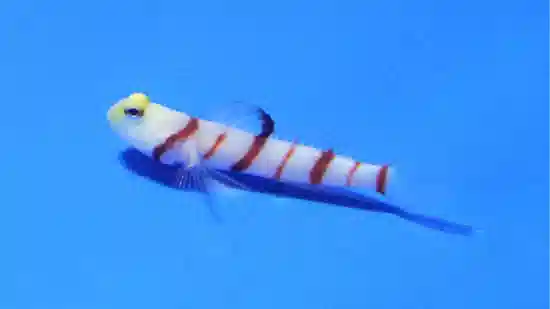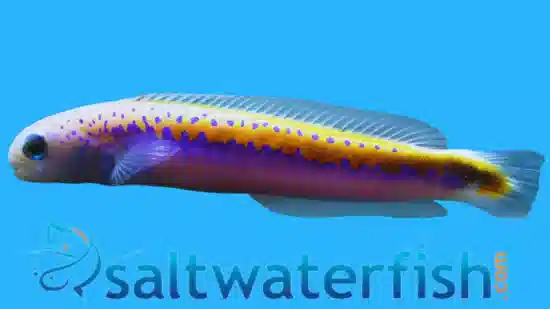Saltwater Gobies In Marine Aquariums: FAQ
Yes, most saltwater gobies are reef-safe and make excellent additions to both fish-only and reef aquariums. With their small size, peaceful nature, and fascinating behaviors, gobies are among the most popular community fish in marine aquaria.
Why gobies are reef-safe:
- Non-aggressive feeders: Many gobies, like Watchman Gobies and Neon Gobies, sift sand or perch on rockwork without disturbing corals.
- Algae and detritus control: Some species consume microalgae or sift sand, helping keep substrates clean.
- Symbiotic behaviors: Iconic pairs like pistol shrimp and gobies form fascinating burrow partnerships, adding both utility and interest.
- Small bio-load: Their modest size means less waste production compared to larger fish.
Scientific research reinforces their reef-friendly role. "Symbiosis between gobiid fishes and alpheid shrimps in Indo-Pacific reefs" (Marine Biology, 1994) documented how gobies actively participate in reef ecosystems without damaging coral, instead enhancing biodiversity and habitat structure. Additionally, behavioral studies ("Cleaning interactions by gobies on Caribbean reefs," Copeia, 2000) highlight how some goby species even improve fish health by acting as cleaners.
Pro Tips for keeping gobies reef-safe:
- Provide fine sand for burrowing species.
- Cover your tank: gobies are known jumpers.
- Pair them with peaceful tank mates; avoid housing them with aggressive wrasses or larger predatory fish.
- Feed a varied diet of frozen mysis, brine shrimp, and pellets to keep them thriving.
Bottom line: Saltwater gobies are among the most reef-compatible fish you can add. They contribute to the health and activity of your tank while staying out of trouble with corals. Browse our reef-safe gobies today and add a hardy, personality-filled companion to your aquarium.
Saltwater gobies are generally omnivorous or carnivorous, and their diets depend on the species. Many thrive on a mix of live or frozen meaty foods (like mysis, brine shrimp, copepods) and prepared small-pellet or flake foods. For example, Diamond Gobies are known to eat sinking pellets, flakes, live mysis, and other small invertebrates. Some gobies, especially sand-sifting ones (e.g. shrimp gobies, Diamond Gobies), also feed on organisms in the substrate, such as small worms and microfauna. Cleaner gobies stitch in/dab parasites off other fish, but they still need regular feedings of meaty food to stay healthy. That behavior is supplemental rather than their entire diet. Because there is species variation, for best results feed a varied diet (meaty foods, pellets, and some live/frozen foods) and observe what your specific goby prefers.
Typical goby diet in aquariums includes:
- Frozen or live foods: mysis shrimp, enriched brine shrimp, copepods, and finely chopped seafood.
- Prepared foods: high-quality pellets and flakes, especially those formulated for small carnivores or omnivores.
- Natural grazing: sand-sifting gobies like Diamond Gobies eat detritus, microalgae, and microorganisms while sifting through substrates.
- Cleaner species: Neon Gobies feed on parasites and mucus from other fish, benefiting tank mates.
Scientific research confirms that many gobies eat a mixed diet, graze algae or detritus, and also consume small invertebrates or animal matter depending on species. For example, Hernaman, Probert & Robbins (2009) studied five coral reef gobies and found that some species were largely herbivorous or detritivorous, while others were carnivorous or omnivorous. (Hernaman, V., Probert, P.K., & Robbins, W.D. (2009). Trophic ecology of coral reef gobies: interspecific, ontogenetic, and seasonal comparison of diet and feeding intensity. Marine Biology)
Pro Feeding Tips:
- Feed small portions 2—3 times daily. Gobies have fast metabolisms.
- For sand sifters, ensure a fine sandbed rich in microfauna.
- Offer variety: rotate frozen mysis, pellets, and live copepods for full nutrition.
- Use target feeding (pipettes or turkey basters) for shy or bottom-dwelling gobies.
Bottom line: Gobies are adaptable eaters that contribute to tank cleanliness while thriving on a mixed diet. With the right feeding routine, they remain hardy, active, and colorful. Browse our reef-safe gobies today and add a personality-filled grazer or sand-sifter to your aquarium.
If your gobies are spending most of their time out of sight, don't worry because this behavior is usually normal. Many goby species are naturally cryptic, living in burrows or crevices as part of their survival strategy.
Common reasons gobies hide include:
- Natural behavior: Species like the Yellow Watchman Goby and Diamond Goby are sand sifters that create burrows and spend much of their time guarding or sifting.
- Stress or acclimation: Newly introduced gobies often hide for days to weeks until they adjust to their environment.
- Tank mates: Aggressive or fast-swimming fish can intimidate gobies, keeping them near burrows.
- Lighting conditions: Bright lights without shaded areas can drive gobies to seek cover.
- Spawning behavior: Some goby pairs hide more when nesting or guarding eggs.
Scientific studies confirm that hiding is adaptive, helping gobies avoid predators while balancing feeding opportunities. Patzner (1999) found that small gobies in the Mediterranean consistently preferred sheltered microhabitats, demonstrating that concealment is central to their ecological success.
Pro Tips to reduce excessive hiding:
- Provide ample rockwork, caves, and sandy areas for natural burrow-building.
- Keep peaceful tank mates to minimize intimidation.
- Feed near their burrow to build trust and coax them out gradually.
- Ensure stable water conditions: stress from swings in salinity or pH can also drive hiding.
Bottom line: Hiding is part of what makes gobies unique. With time, a stable tank, and the right environment, most gobies will venture out more often, especially when food is present. Browse our reef-safe gobies today and enjoy one of the ocean's most fascinating little characters in your reef.
Saltwater gobies are hardy once settled, but they're highly sensitive to sudden shifts in salinity, temperature, and pH. A careful acclimation process dramatically improves survival and helps reduce hiding or stress in the first days.
Step-by-step goby acclimation:
- Dim the lights to minimize stress. Gobies are shy by nature, so a calmer environment eases the transition.
- Float the sealed bag in your aquarium for 15—20 minutes to equalize temperature.
- Set up a drip acclimation: transfer the goby and bag water to a small container, then use airline tubing to drip tank water in at 2—3 drips per second. Continue for 45—90 minutes, until the water volume doubles or triples.
- Net and transfer the goby gently. Never pour shipping water into your tank.
- Release near shelter such as rockwork or a sandbed burrow, so the goby can retreat if it feels threatened.
Scientific research supports why this slow acclimation matters. rapid changes in salinity or handling trigger elevated cortisol and suppress immune function in reef fishes, while gradual acclimation improves survival and recovery (Barton, 2002).
Pro Tips for goby acclimation:
- Cover your tank: many gobies are jumpers, especially when stressed.
- Offer food within 24 hours to encourage early activity.
- For sand-sifters like the Diamond Goby, ensure a fine sandbed is in place before release.
Bottom line: A slow drip acclimation paired with a stress-free introduction helps gobies adjust smoothly, reducing hiding and boosting long-term health. Explore our reef-safe gobies today, each backed by our 8-Day Live Guarantee for confidence.
Yes, gobies are among the hardiest and most adaptable fish you can add to a new reef tank, provided water parameters are stable. Their small size, peaceful nature, and fascinating behaviors make them perfect for aquarists seeking reliability with personality.
Hardy gobies ideal for new reef tanks include:
- Yellow Watchman Goby (Cryptocentrus cinctus) — Known for pairing with pistol shrimp to create burrows. Hardy, adaptable, and a favorite beginner fish.
- Diamond Goby (Valenciennea puellaris) — A dedicated sand-sifter that keeps substrates clean by filtering detritus and uneaten food.
- Neon Goby (Elacatinus oceanops) — Small, peaceful, and doubles as a cleaner fish, picking parasites off tank mates.
- Clown Gobies (Gobiodon spp.) — Perch on coral branches and rockwork, adding bright color and personality even in nano tanks.
Pro Tips for hardy gobies in new tanks:
- Provide fine sand for burrowers and sand sifters.
- Use a tight lid: many gobies are jumpers when startled.
- Feed small meals 2—3 times daily (mysis, brine, pellets) to support their fast metabolism.
- Start with peaceful tank mates to help gobies settle quickly.
Bottom line: Hardy gobies like Watchman, Diamond, Neon, and Clown Gobies are reliable choices for new reef tanks. They add color, activity, and cleaning benefits without overwhelming your system. Browse our full selection of reef-safe gobies today and stock your tank with hardy, personality-filled fish, backed by our 8-Day Live Guarantee.
Saltwater gobies are hardy, adaptable, and full of personality, but they thrive best when their specific needs are met. With the right setup, diet, and tank mates, gobies can live for years while actively contributing to a healthy reef.
Core care requirements for gobies:
- Tank size: Most gobies (like Yellow Watchman and Neon Gobies) do well in tanks as small as 20—30 gallons, while sand-sifters like the Diamond Goby need larger setups (50+ gallons) with fine sand.
- Habitat: Provide rockwork with caves or burrows. Sand-sifters need 2—3 inches of fine sand; perchers prefer stable rock or coral branches.
- Diet: Feed small, frequent meals of mysis shrimp, brine shrimp, copepods, and high-quality pellets. Cleaner gobies may also eat parasites from tank mates but still need supplemental feeding.
- Tank mates: Gobies are peaceful and do best with non-aggressive species. Avoid housing with predatory fish that may view them as food.
- Lid coverage: Gobies are known jumpers, especially when startled. A tight-fitting lid is a must.
Pro Tips for goby care:
- Acclimate slowly with a drip method to avoid stress.
- Offer a varied diet 2—3 times daily to support their high metabolism.
- Pair with pistol shrimp if you want to see fascinating burrow-building behavior (e.g., Watchman Goby + Tiger Pistol Shrimp).
Bottom line: Caring for gobies is straightforward when you provide the right habitat, diet, and tank mates. In return, you'll gain a hardy, colorful, and beneficial reef companion. Browse our reef-safe gobies today, backed by our 8-Day Live Guarantee for peace of mind.
Saltwater gobies are generally hardy, but like all reef fish, they can show clear signs of stress when conditions aren't ideal. Recognizing these signals early allows you to correct issues before they escalate into disease or loss.
Common signs of stress in gobies include:
- Excessive hiding: While many gobies are naturally cryptic, sudden or prolonged withdrawal may indicate stress from aggression, poor acclimation, or unstable water.
- Loss of appetite: Healthy gobies eagerly eat mysis, brine, or pellets. Refusal to feed is a red flag.
- Rapid breathing or gill movement: Often tied to poor oxygenation, ammonia/nitrite spikes, or sudden salinity changes.
- Color fading or blotchy appearance: Stress can cause gobies to lose vibrancy or display patchy markings.
- Erratic swimming or darting: Some gobies may bolt or "jump" when stressed, reinforcing the need for a tight lid.
- Weight loss despite feeding: May indicate internal parasites, often worsened by stress.
Scientific studies confirm that stress in reef fishes manifests in elevated cortisol levels, rapid respiration, reduced feeding, and color changes. Barton (2002) notes that these physiological responses are universal markers of stress in teleost fish, including gobies.
Pro Tips for preventing stress in gobies:
- Acclimate slowly with a drip method to minimize salinity shock.
- Keep tank parameters stable: salinity (1.024—1.026), pH (8.1—8.4), and low nitrates.
- Choose peaceful tank mates and avoid housing gobies with aggressive wrasses or predatory fish.
- Provide plenty of burrows, caves, and live rock for shelter.
Bottom line: Stress in gobies shows up through hiding, loss of appetite, rapid breathing, and faded color. With careful acclimation, stable parameters, and the right tank mates, your goby will thrive. Explore our reef-safe gobies today and enjoy a hardy, low-stress addition to your reef.
Saltwater gobies are among the most peaceful reef fish, making them highly compatible with a wide variety of tankmates. Because most gobies are small, bottom-dwelling, or burrow-associated fish, the best companions are species that occupy different zones of the tank and won't outcompete them for food.
Excellent goby tankmates include:
- Clownfish: Hardy and iconic reef fish that coexist peacefully in the midwater column.
- Cardinalfish: Docile schooling fish that complement gobies' bottom-dwelling habits.
- Blennies: Algae grazers that share some habitat overlap but rarely show aggression.
- Firefish & Dartfish: Peaceful, colorful, and mid-water swimmers.
- Small Wrasses (fairy or flasher): Active but non-aggressive swimmers that add motion without threatening gobies.
- Reef-safe invertebrates: Snails, crabs, and shrimp (especially pistol shrimp, which form famous burrow partnerships with Randall's Goby or Yellow Watchman Goby).
Specific goby examples and their best partners:
- Diamond Goby: Ideal with tangs, wrasses, and clownfish; keeps sandbeds spotless.
- Neon Goby: Pairs well with larger reef fish like tangs and angels, since it cleans parasites.
- Rainford's Goby: Peaceful grazer that thrives alongside blennies and small schooling fish.
- Randall's Shrimp Goby: Does best with pistol shrimp and other peaceful reef species.
- Engineer Goby: A unique burrower that grows larger but remains peaceful. Pair with tangs, angels, and reef-safe wrasses.
Pro Tips for tankmate success:
- Avoid aggressive fish like triggers, large wrasses, or groupers. They may harass or eat gobies.
- Provide plenty of hiding places and sandbeds to reduce stress.
- Feed gobies small, frequent meals, since faster fish often dominate feeding time.
Bottom line: Gobies mix beautifully with peaceful reef fish and invertebrates, from clowns and cardinals to pistol shrimp. Explore our full selection of reef-safe gobies and compatible tankmates to build a vibrant, harmonious aquarium, backed by our 8-Day Live Guarantee.
Gobies and clownfish are two of the most popular marine fish for reef aquariums and the good news is, they're highly compatible in most setups. Both groups are generally peaceful, occupy different zones of the tank, and bring unique behaviors that add balance to your reef.
Top goby choices for pairing with clownfish:
- Yellow Watchman Goby (Cryptocentrus cinctus) — Hardy and full of personality; forms symbiotic burrows with pistol shrimp while clownfish stay in the water column.
- Diamond Goby (Valenciennea puellaris) — Constantly sifts sand, keeping substrates clean while clowns remain near anemones or open water.
- Neon Goby (Elacatinus oceanops) — A cleaner goby that reduces parasites on tank mates, making them beneficial companions.
- Clown Gobies (Gobiodon spp.) — Small perchers that live among coral branches, coexisting peacefully with clownfish.
Pro Tips for a successful clown—goby pairing:
- Choose a tank of at least 30 gallons for smaller gobies with clownfish, or 50+ gallons if adding sand-sifters.
- Provide shelters and burrows for gobies, and an anemone or coral host (if experienced) for clownfish.
- Stick with peaceful community tank mates to maintain harmony.
Bottom line: Gobies and clownfish make an excellent match. Peaceful, complementary, and entertaining. Add both to your tank for color, utility, and personality. Browse our reef-safe gobies and clownfish today, backed by our 8-Day Live Guarantee.
Whether gobies require sand depends on the species and their natural behaviors. Some gobies are burrowers and sand sifters, while others perch on rockwork or coral and don't rely heavily on substrate.
Gobies that need sand:
- Diamond Goby (Valenciennea puellaris) — Actively sifts sand through its mouth, removing detritus and leftover food while keeping the substrate aerated.
- Yellow Watchman Goby (Cryptocentrus cinctus) — Creates and guards burrows, often pairing with pistol shrimp for shelter.
- Other Valenciennea and Cryptocentrus species — Depend on sandbeds to feel secure and to exhibit natural digging and feeding behaviors.
Gobies that do not require sand:
- Neon Goby (Elacatinus oceanops) — A cleaner goby that perches on rockwork or corals and feeds on parasites.
- Clown Gobies (Gobiodon spp.) — Prefer coral branches or rock crevices over sandbeds.
Scientific studies confirm this ecological divide. For instance, Wilson (2002) found that sand-sifting gobies like Valenciennea derive significant nutrition from detritus and algae processed through the substrate, demonstrating why access to sand is essential for their health.
Pro Tips:
- If keeping sand sifters, provide a fine sandbed 2—3 inches deep for burrowing and feeding.
- Use live sand for added microfauna, which supports natural foraging.
- For non-sand species, focus on stable rock structures and hiding places instead.
Bottom line: Not all gobies need sand, but for species like Diamond or Watchman Gobies, a sandbed is essential to their health and natural behavior. Choose your goby based on your aquarium's setup, and explore our full selection of reef-safe gobies to find the perfect fit for your reef.
Gobies are some of the most rewarding fish for new marine aquarists. They're hardy, peaceful, and full of personality, often displaying unique behaviors that make them fascinating to watch. Several species are particularly well-suited for beginners while still bringing variety and interest to your reef.
Some beginner-friendly gobies:
- Yellow Watchman Shrimpgoby (Cryptocentrus cinctus) — A hardy species known for pairing with pistol shrimp to create burrows. Their bold stance and watchful behavior add both function and character.
- Blue Neon Goby (Elacatinus oceanops) — Small, peaceful, and known for their "cleaner" behavior, picking parasites from other fish. Excellent in nano reefs.
- Diamond Goby (Valenciennea puellaris) — Active sand sifters that constantly filter substrate for food, keeping sandbeds clean and aerated.
Pro Tips for beginner goby keepers:
- Provide fine sand for sifters and ample rockwork for perchers.
- Keep a tight-fitting lid: many gobies are jumpers.
- Feed a mix of frozen mysis, brine shrimp, and small pellets 2—3 times daily.
Bottom line: Beginner aquarists don't need to sacrifice interest for hardiness. Species like Watchman, Neon, and Diamond Gobies combine resilience with engaging behaviors. Browse our full selection of beginner-friendly gobies today and add a hardy, entertaining companion to your reef, backed by our 8-Day Live Guarantee.
Gobies may be small, but they punch far above their weight when it comes to aquarium maintenance. Different goby species fill unique ecological niches, and together they provide natural cleaning services that reduce manual upkeep.
Ways gobies help keep tanks clean:
- Sand-sifting gobies like the Diamond Goby constantly take in mouthfuls of sand, filtering out detritus, uneaten food, and microalgae. This prevents waste buildup and keeps substrates aerated.
- Cleaner gobies such as Neon Gobies pick parasites and dead tissue directly from other fish, improving the overall health of your aquarium community.
- Detritus foragers like Watchman Gobies sift through the bottom layers of the tank, recycling organic material and keeping the substrate oxygenated.
- Microalgae grazers consume biofilm and microscopic algae that would otherwise fuel nuisance growth.
Scientific studies confirm these benefits. For example, Whiteman (2005) demonstrated that cleaner gobies significantly reduce parasite loads in reef fishes, directly improving the health of surrounding fish populations.
Pro Tips for maximizing their cleaning role:
- Keep a fine sandbed (1—2 inches) for sifters like Diamond Gobies.
- Pair cleaner gobies with larger reef fish to see natural cleaning interactions.
- Offer a balanced diet (mysis, pellets, brine shrimp) to keep them strong enough for continuous foraging.
Bottom line: Gobies are more than colorful additions, they're natural cleaners that control detritus, parasites, and algae, making your reef healthier and easier to maintain. Explore our reef-safe gobies today and add a hardworking little helper to your tank.

